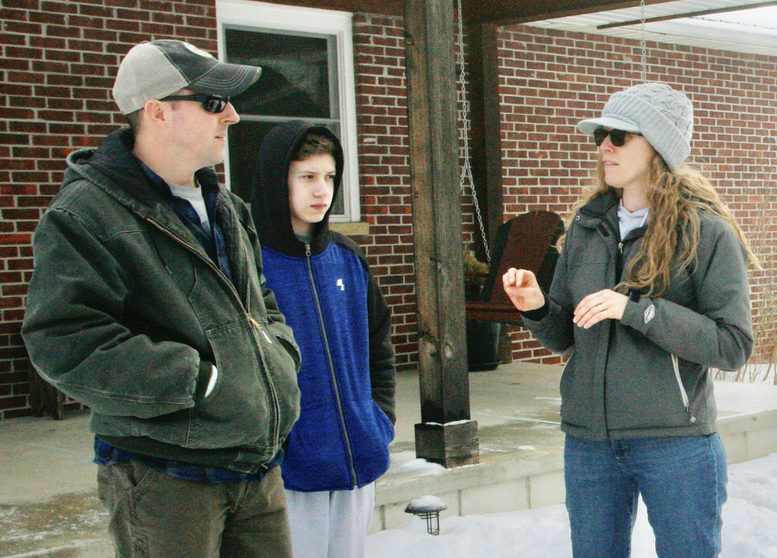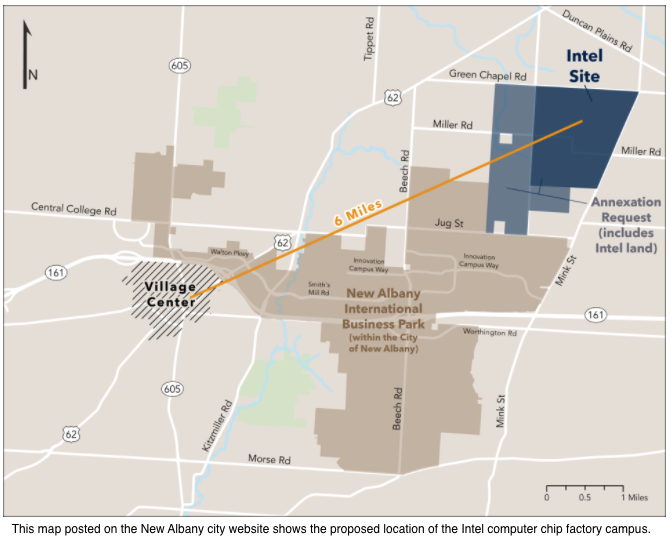As the bee flies, the Latshaw Apiaries are four miles from where Intel plans to build the largest computer chip factory in the world on 3,000-plus acres of Jersey Township slated for development.
The Latshaws — Joe, Leah and their son, Jacob — are not landowners or homeowners within the possible footprint of the proposed Intel campus in central Ohio. And yet, they represent the ripple effect of such a massive development on families, farming, schools, roads, and the environment, including honey bees.

In the springtime, the Latshaws’ bees will buzz with life as they race against the sun to make their honey and pollinate blossoms all around them. But on a recent frosty February day, thousands of the bees hid inside their nucleus colonies, or miniature hives, unseen and protected, safe from the winter chill.
The Latshaws have colonies in the woods behind their house, and they have thousands more bees resting on nearby farms. The Latshaws typically make handshake agreements with area farmers to place hives on their land in exchange for some of the honey.
Latshaw Apiaries is a family owned and operated business, raising bees with the goal of producing great local honey. They sell their pure, raw, and creamed honey at Granville and New Albany farmers markets. Their honey also is on the shelves of a few area shops such as Comfrey Corner of Heath and at Black Radish Creamery at the North Market in Columbus.
Joe and Leah Latshaw recently learned from a customer that they would have to relocate their Jersey Township bees. “A realtor at the farmers market, you know, told us that this is coming, and we just haven’t heard exactly where,” Joe said.
Joe told the story while standing near the 60-70 quiet colonies in the warm evening glow of sunlight in late winter. “I don’t know if it is a news story that we have.”

The Latshaws typically are on the lookout for places to house their colonies. “We always have our ears open, because we’ve had situations in the past where a landowner sells, and we don’t have the ability to keep those bees there anymore. So we’re always kind of on alert for more space,” Leah said.
“But this was kind of like, ‘Oh, dear!’” Leah exclaimed with a nervous laugh and cheeks flushed from the cold. The couple took to Facebook soon after the Intel announcement in hopes of finding a home for their bees.
Since then, they have had a few people offer to meet with them about possible new locations. Joe and Leah aim for grazing lands, woodlands, and natural areas for their bees. “Bees forage over such a large area,” Joe explained, and they need a variety of plants blooming around them.
The asphalt parking lots and new residential spaces that the development will bring make it more difficult to find nearby natural spaces.
In late January, Ohio secured a deal with Intel that is expected to bring upward of 3,000 Intel jobs and “tens of thousands” of long-term jobs in nearby communities, such as Johnstown and Newark, according to Intel’s news release. The Columbus suburb of New Albany is annexing more than 3,000 acres of Jersey Township, in Licking County, for the “mega-site” that is set to be one of the largest semiconductor manufacturing sites in the world.

According to The Columbus Dispatch, the state of Ohio offered an incentive package worth $2 billion for the $20 billion development. Intel promises to invest $100 million in partnerships with educational institutions and the U.S. National Science Foundation to advance Ohio’s role in technology and production.
The ripple effect being felt by the Latshaws is one of many that will emerge in this corner of Licking County, which will become part of the New Albany International Business Park after annexation by the city. Drive along Jug Street, as well as Beech, Mink, Miller, Clover Valley and Green Chapel roads, just north of State Route 161, the four-lane (soon to be six-lane) artery that links Columbus to New Albany to Granville to Newark. The land between those rural roads is not empty: It’s cropland and farmsteads, and it has been that way since Jersey Township was established in 1820 by settlers from New Jersey.
The country roads are lined with dream homes, some new and some old. And life there is about to change in dramatic ways.
“It’s just going to explode, and you’re seeing it already with things coming out the 161 corridor,” Joe Latshaw said. “This is going to be a big jump in a hurry.”
This is all to say that the Intel project is a big deal.
The Reporting Project at Denison University is going to document this project and the changes it will bring to central Ohio, and Licking County in particular, and we need your help. How did you learn about the Intel project? What questions do you have about it? What does this land mean to you and your family? What impact do you think it will have on your life?
If you have a story to share or questions for the reporting team to consider for future stories, please email us at thereportingproject@denison.edu.


